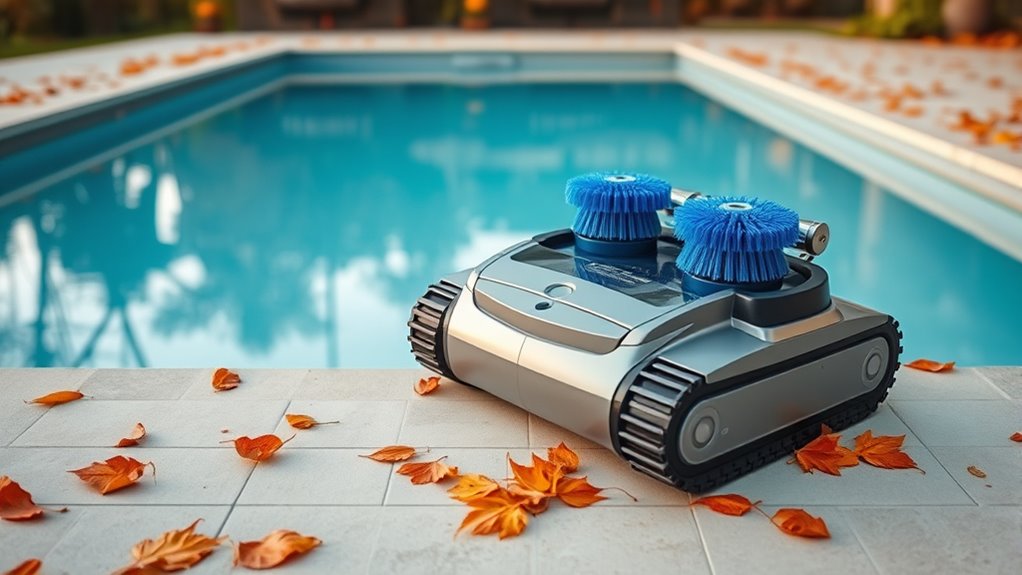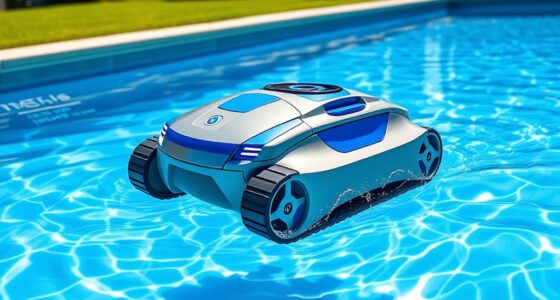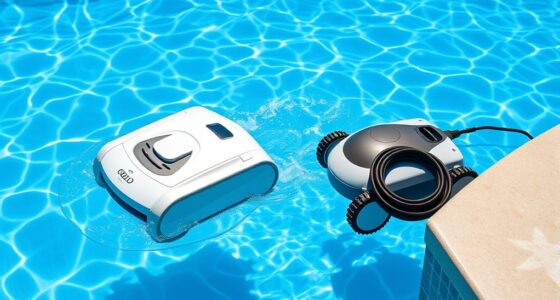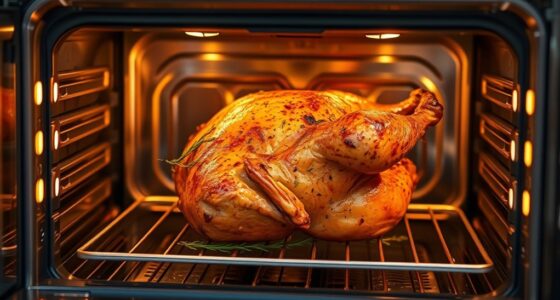To properly care for your pressure pool cleaner during off-season, rinse all parts thoroughly with fresh water to remove chlorine and debris. Dry everything completely, then store it in a sheltered, cool, and dry spot away from direct sunlight. Check for any damage or wear, and loosen hoses to prevent cracking. Proper storage and maintenance now will keep your cleaner in top shape and ready to perform when swimming season returns. Learn more tips to keep it in great condition.
Key Takeaways
- Rinse and thoroughly clean the entire cleaner, hoses, and brushes to remove chlorine, dirt, and debris before storage.
- Store the cleaner in a sheltered, cool, dry place away from direct sunlight and extreme temperatures.
- Inspect all components for damage, replace worn parts, and ensure filters and internal parts are clean.
- Loosen hoses and flexible parts to prevent cracking or bending during off-season storage.
- Elevate and organize the equipment to prevent moisture, pests, and accidental damage, ensuring readiness for next season.
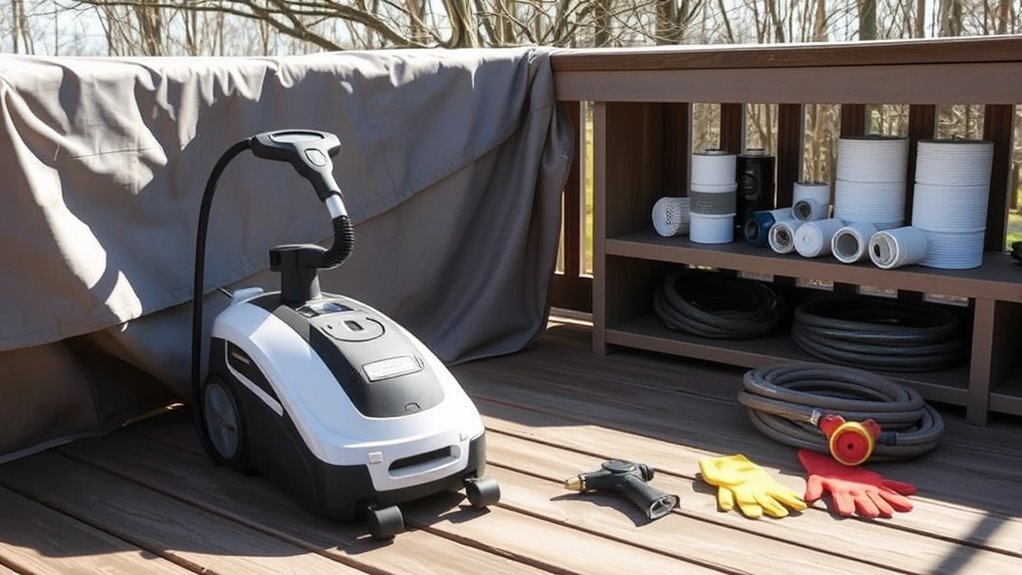
As the swimming season winds down, it’s essential to give your pressure pool cleaner proper off-season care to guarantee it stays in top condition. The key steps involve careful storage maintenance and thorough equipment inspection. Proper storage maintenance prevents damage caused by the elements or neglect, guaranteeing your cleaner is ready to perform when swimming season resumes. Before putting it away, rinse off the entire unit with fresh water to remove chlorine, dirt, and debris that can corrode parts or cause buildup. Pay special attention to the hoses, brushes, and wheels, ensuring they’re free of any residual residue. Once cleaned, dry the components thoroughly to prevent mold or rust from developing during storage.
Proper off-season care keeps your pressure pool cleaner in top condition for next season.
Next, focus on storage maintenance by choosing an appropriate, sheltered location. Avoid leaving your pressure cleaner in direct sunlight or exposed to extreme temperatures, as these conditions can degrade plastic parts and hoses over time. A cool, dry, and shaded spot, like a garage or shed, is ideal. If possible, elevate the unit off the ground to prevent moisture accumulation and pest intrusion. Consider loosening or removing hoses and other flexible parts to prevent cracking or bending from prolonged compression. Storing the cleaner in a clean, organized manner helps prevent accidental damage or misplacement of parts, saving you time and effort when you’re ready to use it again. Additionally, applying protective coatings to vulnerable parts can help extend the lifespan of your equipment during storage.
Equally important is equipment inspection before storage. Carefully examine all components for signs of wear or damage. Check the hoses for cracks, leaks, or blockages, and replace any compromised sections. Inspect the brushes and wheels for excessive wear, and replace them if necessary. Make sure the filter and any internal parts are clean and functioning properly. Tighten any loose fittings or connections to avoid leaks or malfunctions during the next season. If your pressure cleaner has a power cord, inspect it for frays or exposed wires, and store it loosely to prevent bending or damage. Additionally, be aware of the increasing use of automation technologies in related industries, which can influence how equipment like pressure cleaners might evolve in the future.
Taking these steps ensures your pressure pool cleaner remains in good shape during the off-season. Proper storage maintenance and equipment inspection extend the lifespan of your device, make startup smoother when you’re ready to go, and save you from costly repairs or replacements down the line. When spring arrives, a quick inspection and cleaning will have your pressure cleaner ready to roll, keeping your pool pristine without a hitch. Treat your equipment well during the off-season, and it’ll reward you with reliable performance season after season.
Frequently Asked Questions
Can Pressure Pool Cleaners Be Stored Outdoors During Winter?
You might wonder if you can leave your pressure pool cleaner outdoors during winter exposure. While outdoor storage is possible, it’s not ideal because harsh weather can damage the equipment. To protect it, store your pressure cleaner in a sheltered area, away from snow and moisture. This prevents freezing and corrosion, ensuring your device stays in good condition for when swimming season returns.
How Often Should I Inspect My Pressure Cleaner During the Off-Season?
Think of your pressure pool cleaner as a trusty steed awaiting spring. You should inspect it at least once a month during the off-season. Follow your maintenance checklist closely to catch any issues early. An inspection schedule helps prevent surprises when you’re ready to use it again. Keep an eye on hoses, connectors, and seals, ensuring everything’s in good shape so your cleaner’s ready to roll when the season starts.
Is It Necessary to Drain the Pressure Hose Before Storage?
Yes, it’s necessary to drain the pressure hose before storage to prevent water from freezing and causing damage. Proper hose drainage is a key step in storage preparation, guaranteeing no residual water remains inside. This helps avoid cracks, leaks, or mold growth. Before storing your pressure pool cleaner, make sure to thoroughly drain the hose and store it in a dry, cool place to prolong its lifespan and ensure ideal performance when you use it again.
What Are Common Signs of Pressure Cleaner Damage After Winter?
After winter, look for damage indicators on your pressure cleaner, like cracks, leaks, or worn hoses. These signs often result from winter wear, which can weaken parts over time. Check the motor and connections for corrosion or rust. If you notice any irregularities or reduced performance, it’s a clear sign your pressure cleaner might have sustained damage during the off-season, and it’s time for repairs or replacement.
Should I Lubricate Parts Before Storing My Pressure Pool Cleaner?
Think of your pressure pool cleaner as a finely-tuned instrument needing care to sing again next season. Before storage, you should definitely perform lubrication maintenance on moving parts. This simple step protects against rust and corrosion, ensuring smooth operation later. Proper storage preparation, including lubrication, keeps your cleaner in top shape, ready to spring into action when the season starts. Don’t skip this; your cleaner will thank you with reliable performance.
Conclusion
Properly caring for your pressure pool cleaner during the off-season guarantees it stays in top condition for years to come. For example, imagine you store your cleaner correctly over winter; come spring, it starts up smoothly, saving you time and repair costs. By following these simple steps—cleaning, draining, and storing properly—you’ll keep your equipment ready for effortless pool maintenance. Invest a little effort now, and you’ll enjoy a hassle-free swim season ahead.
